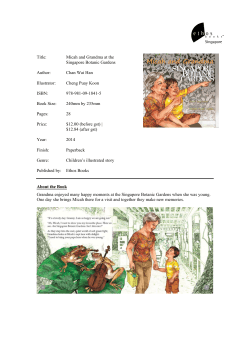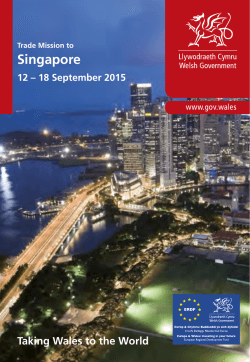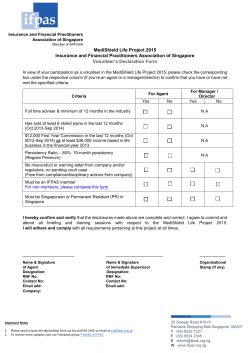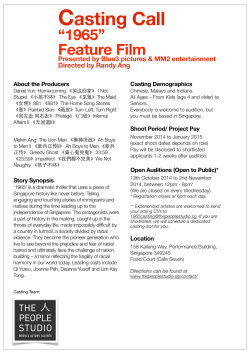
- Journal of International Affairs
Book Reviews A NARR ATI V E OF LOW-WAGE MIGR ANTS IN SINGAPORE Xin Yi Cheow A Review of A Thousand and One Days: Stories of Hardship from South Asian Migrant Workers in Singapore Edited by Sallie Yea, A.K.M. Mohsin, and Debbie Fordyce (Singapore: Banglar Kantha Publications, 2014), 72 pages. As a migrant worker in Singapore, Saddam remembers 20 December 2010 as the day when a workplace accident washed all his dreams away. The Bangladeshi national, who was working in construction at the time, fell from a wall into a drain, fracturing two bones below the left knee. Shortly after the incident, he fled his dormitory to escape the clutches of “a team of gangsters” hired by his employer to send him back to Bangladesh after the employer had refused to buy state-mandated insurance for Saddam’s accident or pay him medical leave wages.1 Still nursing his injury and already in debt from paying recruitment fees to migrate, Saddam was close to sleeping on the streets before he received the kindness of a civil society activist, who put him up in her home to recover and resolve his injury claims in Singapore.2 He received only a third of his work injury compensation due to a lack of insurance, but received the remainder in installments after returning to Bangladesh.3 Saddam’s story, recounted like a diary entry in a first-person perspective, has one of the better endings in A Thousand and One Days: Stories of Hardship from South Asian Migrant Workers in Singapore, a collection of eight challenging migration experiences in the Southeast Asian city-state. As its title suggests, A Thousand and One Days paints a sobering picture of the downsides of labor migration in the age of economic globalization. The stories presented are also a reflection of the inadequacies of the government policy apparatus in Singapore to deal with the unique challenges faced by low-skilled migrant workers within the country. Seven of the featured migrants work in the construction industry and one was trafficked for commercial sexual exploitation. They often attribute their hardships to personal bad luck, but the editors argue that the poor outcomes, exploitative laboring, and protracted cases of work injury claims and salary disputes are more a product of Singapore’s flawed labor migration system.4 In the book’s introduction, editors Sallie Yea and Debbie Fordyce—both civil society activists at the forefront of migrant advocacy efforts in Singapore— described Singapore as a deeply neoliberal state, which has achieved rapid development through the policies of a strong government that favors the interests of busi332 | Journal of international affairS Book Reviews ness and capital over labor, especially foreign labor.5 When employers fail to adhere to regulations, ensuring that workers receive justice and compensation is a difficult and protracted process, which is illustrated through the eight stories presented by the migrants featured in the book.6 Foreign labor comprises nearly 38 percent of the total workforce in Singapore.7 While government policy currently encourages high-skilled professional foreign labor, or “foreign talent,” with liberalized immigration policies that ease requirements for permanent residence and citizenship, Singapore’s government has adopted a more restrictive policy toward low-skilled foreign labor. Low-skilled immigrants work in “dirty, demeaning, and dangerous” (“3D”) jobs shunned by better-educated and increasingly affluent Singaporeans, such as the construction, shipyard, and domestic work sectors.8 Singapore controls their numbers through work permits, levies, and dependency ceilings.9 Yet low-skilled foreign labor, called “work permit holders,” make up the bulk of Singapore’s foreign workforce, with those in construction alone comprising almost 25 percent of the total foreign workforce of about 1.3 million.10 Activists, local nongovernmental organizations, and international media have long decried the treatment of these workers in Singapore. Failure to enforce the protection of migrant workers’ rights and address their substandard employment and living conditions has been considered an underlying cause of a 2013 riot in Singapore’s Little India neighborhood, which involved hundreds of South Asian migrants—although Singapore’s government refutes this claim.11 A 2014 report by a Committee of Inquiry, set up by Singapore’s Ministry of Home Affairs to investigate the riot—considered Singapore’s worst major public order incident in over four decades—cited neither underemployment nor poor living conditions as causes of the riot. Noting Singapore as a “top choice” for migrant labor, the committee nevertheless acknowledged areas for improvement, including accommodations, high recruitment fees, and employment processes, and offered suggestions for relevant ministries in Singapore to be “on guard for any deterioration” in migrants’ employment or living conditions.12 Given the heightened discourse around the treatment of migrant labor in Singapore and the nuances surrounding the issue, the publication of A Thousand and One Days is a timely and insightful addition to the discussion. Part portrait into the workers’ motivations for migrating and part cautionary tale for future migrants to Singapore, the book’s introduction also provides incisive analysis on the root causes underpinning the challenges of low-skilled labor migration in Singapore. The greatest strength of the book is its ability to humanize workers’ struggles Spring/Summer 2015 | 333 Book Reviews by framing the narration through their eyes. Indeed, the first thing that strikes a reader is the book’s simplicity of language. Beneath the bare-bone prose are telling snapshots and vivid renditions of what a migrant’s life in Singapore entails, each chapter framed by a summary contextualizing the main issues that worker faces, and the status of resolution, if any. A chapter by Ashraful, who suffers a serious workplace injury, for example, reads at first like a mundane laundry list, but in fact portrays the deterioration of his mental and emotional state due to the lengthy wait for his case to be resolved and his anxiety over heightening financial issues.13 In another chapter, Mohammed describes eating rice with “small particles of dirt” and “curry with two pieces of potato and one piece of fish, but the fish is sometimes missing,” as food for convalescence over his leg injury.14 And Ziaur, who was subjected to labor trafficking, speaks of his boss threatening to withhold his salary if he refused to work for thirty-six straight hours. (As testament to the numerous vicissitudes that the laborers face, pseudonyms were used for each worker, as some of them are still working in Singapore or want to visit again “having previously failed to meet their financial goals.”)15 Perhaps what is missing from the book is a balancing perspective from the government or the private sector. Some workers’ accounts illustrating the inadequacies of Singapore’s healthcare and social justice system could be construed as one-sided given the inability to verify their claims. Readers unfamiliar with Singapore’s labor system and socioeconomic context might also find it difficult to grasp the implications of some workers’ recounting of their encounters with state agencies, although the book has tried to mitigate confusion by providing a glossary of acronyms and technical terms. Finally, while the book features a list of advice for migrant workers coming to Singapore, it misses the chance to elucidate specific policy recommendations to improve their living and employment conditions. This is especially the case given the availability of a poignant channel through which to convey them—the workers’ personal narratives. Ultimately though, whatever the book lacks from a policy perspective, it makes up for in its storytelling prowess. Low-wage migrant workers in Singapore are often seen as marginalized and voiceless, a problem exacerbated by their general lack of fluency in English. A Thousand and One Days is thus significant for its attempt to translate workers’ thoughts and, in the words of the editors, to “place the migrants at the center rather than at the margins when contemplating their struggles, challenges, and small victories.” Such storytelling is in itself an empowering tool for understanding migration and offers a unique window of insight for anyone especially interested in migration issues in Asia. 334 | Journal of international affairS Book Reviews NOTES 1 Sallie Yea, A.K.M. Mohsin, and Debbie Fordyce, eds., A Thousand and One Days: Stories of Hardship from South Asian Migrant Workers in Singapore (Singapore: Banglar Kantha Publications, 2014), 46. 2 Ibid., 46. 3 Ibid., 45. 4 Ibid., 5. 5 Ibid., 5. 6 Ibid., 5. 7 Foreign labor percentage of total labor force in Singapore was calculated from information provided by Singapore’s Ministry of Manpower, available at http://stats.mom.gov.sg/Pages/Home.aspx. 8 Siow Yue Chia, “Foreign labor in singapore: Rationale, policies, impacts, and issues,” Philippine Journal of Development 38, 1 (2011), 107. 9 Ibid., 105. 10 “Foreign Workforce Numbers,” Singapore Ministry of Manpower (accessed January 2015), http:// www.mom.gov.sg/statistics-publications/others/statistics/Pages/ForeignWorkforceNumbers.aspx. 11 Goh Chin Lian, “Singapore objects to New York Times’ editorial on riot in Little India,” Straits Times, 19 January 2014, http://www.straitstimes.com/the-big-story/little-india-riot/story/singaporeobjects-new-york-times-editorial-riot-little-india-2. 12 Report of the Committee of Inquiry into the Little India Riot on 8 December 2013, (27 June 2014), http:// www.mha.gov.sg/Data/Files/file/Little%20India%20Riot%20COI%20report%20-%202014-06-27.pdf. 13 Yea, Mohsin, and Fordyce, 23–27. 14 Ibid., 32. 15 Ibid., 43. Spring/Summer 2015 | 335
© Copyright 2025









